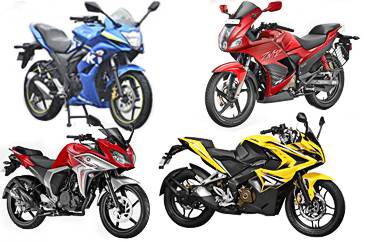Suzuki’s naked Gixxer pleasantly surprised us last year and set the bar high with its fresh and eye-catching looks, up-to-date features, good performance and handling. Now, Suzuki’s new fully-faired Gixxer SF promises to take their new-found benchmark baton forward. Let’s take a look at how the new motorcycle fairs in terms of specifications on paper.
Displacement
The Hero Karizma makes a strong point here with its 223cc engine, but then again, the engine is a bit old. On the heels of the Karizma is the new Bajaj Pulsar RS200 making 199.5cc from its liquid-cooled engine. The Gixxer SF displaces 155cc and does overtake the Yamaha Fazer V2.0 in this area.
Power
The Bajaj Pulsar RS200 makes the most power here delivering 24.2bhp at 9,750rpm. The new Pulsar uses an advanced liquid-cooled engine that was developed by Bajaj and KTM together, making it the most potent one on the list here. The Hero Karizma makes 19.2bhp at 7,500rpm which stands tall compared to the 150cc motorcycles here. The Suzuki Gixxer SF makes a decent 14.6bhp at 8,000rpm.
Torque
The Hero Karizma makes 2kgm of torque at 6,000rpm which makes it the most torque-laden motorcycle in the comparison. The Bajaj Pulsar RS200 makes just a bit short — 1.9kgm of torque at 8,000rpm. The Suzuki Gixxer SF makes 1.43kgm of torque at 6,000rpm stepping up from the Yamaha Fazer V2.0 by a fraction, as it makes 1.3kgm of torque at 6,000rpm.
Suspension
All four motorcycles in the comparison use telescopic forks up front. On the rear, all except the Hero Karizma use a monoshock suspension with a box-section swingarm. The Karizma has gas-filled dual shocks at rear, also using a box-section swingarm.
Fuel tank capacity
The Hero Karizma has a 15-litre fuel tank and the Bajaj Pulsar RS200 has a 13 litre one. The Suzuki Gixxer SF and the Yamaha Fazer V2.0 use decent-sized 12-litre fuel tanks.
Brakes
All four motorcycles in the comparison use disc brakes up front. The Bajaj Pulsar RS200 however is the only one in the comparison that uses a disc brake at rear for braking, the rest of the motorcycles use drum brakes. Bajaj’s Pulsar RS200 also is the only motorcycle in the comparison that offers an ABS braking system, which however comes at a price.
Weight
The Yamaha Fazer V2.0 weighs 132kg, making it the lightest in the comparison here. The Suzuki Gixxer SF, due to its fully faired attire, weighs 139kg. The Bajaj Pulsar RS200 weighs 165kg, making it the heaviest in the competition.
Dimensions
The Hero Karizma beats the Suzuki Gixxer SF by 50mm to be the longest motorcycle here.
The Karizma is also the widest motorcycle, and even though the Pulsar is equipped with a full fairing, it manages to retain the narrowest stance. Hero’s Karizma is the tallest motorcycle too, followed closely by the Bajaj Pulsar.
Price
The Suzuki Gixxer SF, the Yamaha Fazer V2.0 and the Hero Karizma cost almost the same at just above Rs 83,000 (ex-showroom, Delhi). The Bajaj Pulsar is more expensive due to the technical advancement it comes loaded with, costing Rs 1.18 lakh for the non-ABS version and Rs 1.30 lakh for the one with a single channel ABS braking system upfront.




Comments
Member Login
Personal Details
No comments yet. Be the first to comment.